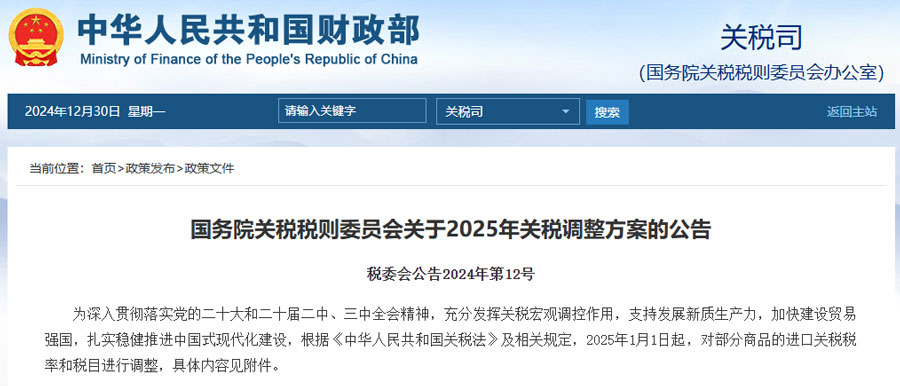


On December 28, the Tariff Commission of The State Council issued the 2025 Tariff Adjustment Plan (hereinafter referred to as the "Plan"). The plan, which will be implemented from January 1, 2025, will help increase imports of high-quality products, expand domestic demand, promote high-level opening up to the outside world, and solidly promote high-quality development.
In order to enhance the linkage effect of the two resources in both domestic and international markets, provisional import tax rates lower than the most-favoured-nation rate will be applied to 935 commodities in 2025. First, support the development of new quality productivity through scientific and technological innovation, and reduce import tariffs on cycloolefin polymers, ethylene-vinyl alcohol copolymers, automatic transmissions of special purpose vehicles such as fire trucks and emergency repair vehicles. The second is to ensure and improve people's livelihood in the development, and reduce import tariffs on sodium zirconium silicate, viral vectors for CAR-T tumor therapy, and nickel-titanium alloy wire for surgical implantation. Third, promote green and low-carbon development, and reduce import tariffs on ethane and some recycled copper and aluminum raw materials. In addition, according to the development of domestic industries and changes in supply and demand, within the scope of China's accession to the World Trade Organization commitments, the import tariffs on some commodities such as syrup and sugar-containing premixed powder, vinyl chloride, and battery separator will be increased.
In order to expand the global network of high-standard free trade zones, by 2025, agreed tax rates will be applied to some imported goods under 24 free trade agreements and preferential trade arrangements originating in 34 countries or regions. Among them, the China-Maldives Free Trade Agreement will take effect from January 1, 2025 and implement tax reduction, and after the final tax reduction in the future, close to 96% of tax items on both sides will achieve zero tariff.
In order to help the least developed countries develop and achieve mutual benefit and win-win results, China will continue to grant zero tariff treatment to 100 percent of the products of the 43 least developed countries that have established diplomatic relations with China in 2025. At the same time, we will continue to apply preferential tariff rates to some imported goods originating from Bangladesh, Laos, Cambodia and Myanmar in accordance with the Asia-Pacific Trade Agreement and the exchange of Letters agreement between the governments of relevant ASEAN member states.
In order to serve the development of the industry and scientific and technological progress, in 2025, the national sub-items such as pure electric passenger cars, canned eryngii mushrooms, spodumene, ethane, etc. will be added, and the expression of the names of tax items such as coconut water and made feed additives will be optimized. After adjustment, the total number of tariff items is 8960. At the same time, in order to promote the scientific and standardized tax system, in 2025, new annotations for domestic subheadings such as dried nori, carburizing agents, and injection molding machines will be added, and the expression of annotations for domestic subheadings such as liquor, wood activated carbon, and thermal printing will be optimized.





